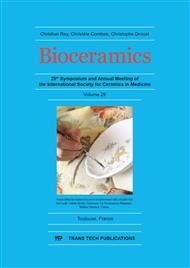p.194
p.199
p.204
p.210
p.217
p.223
p.228
p.234
p.239
Algorithms for Clinical Indications of Bone Substitutes - Component of Training in Orthopaedic Surgery
Abstract:
Modern traumatology is characterised by increasingly severe injuries, with significant soft tissue and bone loss; therefore, restoration of functional anatomy regards bone filling with proper bone integration, and otherwise surgical reconstruction is useless. Therefore, orthopaedic surgeons must have not only surgical skills, but thorough knowledge about the properties and indications of bone substitutes, which can improve surgical results in treating especially comminuted fractures. Integrating the clinical experience from a Level 1 Trauma Centre with didactic principles, and using e-learning as an educational tool, this paper refers to establishing an algorithm of clinical indications of bone substitutes in orthopaedic surgery and to introducing it into the educational process of orthopaedic trainees, as a component of vocational training.
Info:
Periodical:
Pages:
217-222
Citation:
Online since:
November 2017
Authors:
Keywords:
Price:
Сopyright:
© 2017 Trans Tech Publications Ltd. All Rights Reserved
Share:
Citation:


